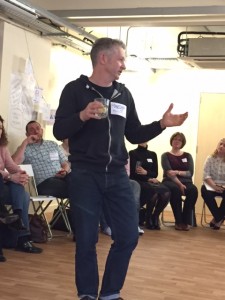 There are plenty of examples of trainers who have made the move from being purely face to face trainers and facilitators to being online trainers and facilitators. Michelle Parry-Slater is one of them. She is now so impressed with what can be done online that she now prefers online facilitation, above anything else. “You can do so much, without people having to leave their desks or take much time out of work. Plus, you can reach more people – I can run a webinar for 150 people.” (image of Michelle Parry-Slater on LearningNow TV)
There are plenty of examples of trainers who have made the move from being purely face to face trainers and facilitators to being online trainers and facilitators. Michelle Parry-Slater is one of them. She is now so impressed with what can be done online that she now prefers online facilitation, above anything else. “You can do so much, without people having to leave their desks or take much time out of work. Plus, you can reach more people – I can run a webinar for 150 people.” (image of Michelle Parry-Slater on LearningNow TV)
Parry-Slater, who runs her own consultancy business called Kairos Modern Learning, facilitates live online classes for the CIPD. This year her and the CIPD are also launching a new webinar programme called ‘How to be a great webinar facilitator’.
 Not all traditional trainers and facilitators have been able to transfer their skills online, partly because of the fear factor and lack of knowhow. But, there’s a whole raft of information and advice on how people can and should facilitate online. On the topic of synchronous facilitation, there’s Don Taylor’s book ‘Webinar Master’ and Stella Collins and Andy Lancaster’s ‘Webinars Pocketbook’, for example. And now there is this blog as well!
Not all traditional trainers and facilitators have been able to transfer their skills online, partly because of the fear factor and lack of knowhow. But, there’s a whole raft of information and advice on how people can and should facilitate online. On the topic of synchronous facilitation, there’s Don Taylor’s book ‘Webinar Master’ and Stella Collins and Andy Lancaster’s ‘Webinars Pocketbook’, for example. And now there is this blog as well!
There are lots of similarities between traditional facilitating and online facilitating, but there are also differences and those differences need to be understood. We talked about those differences in our previous post in this series.
Perhaps the number one piece of advice for a traditional, face to face facilitator who wants to make the move into the online space is to be aware of these differences, both as limitations and as strengths.
It’s not that face to face facilitators have to ditch everything they have done previously and start again. Facilitation is a transferrable skill. However, some adjustments do need to be made. “Just because you’re a great face to face trainer is not enough,” says Parry-Slater. For Parry-Slater, the real biggie is engaging with your audience. “One of the things that has to be considered is how you engage with the people that you can’t see. That is the biggest fear of face to face facilitators and also the biggest thing to get right.”
Kevin Wyke, founder and director of the people and organisation development company Leap Further, agrees. “Online, there is a challenge around how you create that social bit of dialogue and interaction,” says Wyke. “Technology can get in the way and stop people from acting in a human fashion.”
However, both Wyke and Parry-Slater are quick to point out that this is by no means an insurmountable challenge, just one that needs to be considered and planned for. The essential elements of facilitation translate across both mediums. “Great facilitation is about creating a space where people can explore something, whether you are doing that in a physical space or virtually,” says Wyke. And “You shouldn’t just talk at people whether you’re in a classroom or online,” adds Parry-Slater.
Know your audience and use all that technology has to offer to support your aim. Learning technologies can indeed reduce costs and scale things up, but it can also enhance and enrich the learning experience. We will explore this further in our next post in our series on online facilitation.
 Wyke is a big fan of Open Space, World Café and Street Wisdom – the sense of community and openness these methods enables. His preferences when it comes to technology are informed by the same reasons. “I am using Noddlepod to support the building of learning communities, particularly in some of the larger leadership development programmes I am part of. With it you can build a really strong peer learning community that lasts longer than the face to face part of the programme.” (image of Kev Wyke facilitating an Open Space session at LnDConnect)
Wyke is a big fan of Open Space, World Café and Street Wisdom – the sense of community and openness these methods enables. His preferences when it comes to technology are informed by the same reasons. “I am using Noddlepod to support the building of learning communities, particularly in some of the larger leadership development programmes I am part of. With it you can build a really strong peer learning community that lasts longer than the face to face part of the programme.” (image of Kev Wyke facilitating an Open Space session at LnDConnect)
"Going online” is not about dropping face-to-face. It is about expanding the toolkit available to you in meeting your learner's needs. There are tools to enable breakout sessions. There are live chat functions. It is important to use platforms that support reflection and knowledge sharing - this encourages deeper, more meaningful learning. There are both synchronous (e.g. webinars) and asynchronous (e.g. community building) platforms that are geared towards facilitation.
The role of the host, the facilitator, is to ensure that participants are actively engaged and doing what they are supposed to be doing – ie. participating.
 With traditional facilitating, the space can be set up to welcome people and facilitators can do a meet and greet. It is more obvious how to make the event inclusive. “You have to be that intentional in the virtual space too,” says Wyke. It just takes a bit of forethought and planning, as it does with the physical space too.
With traditional facilitating, the space can be set up to welcome people and facilitators can do a meet and greet. It is more obvious how to make the event inclusive. “You have to be that intentional in the virtual space too,” says Wyke. It just takes a bit of forethought and planning, as it does with the physical space too.
Parry-Slater has a few words of advice for any seasoned facilitators – or indeed, any aspiring facilitators – who are keen to enter the online world of facilitation. “Jump in and have a go. You can do it formally, through courses. Or, start as a lurker – go to webinars and see how other people are doing it. There is lots of stuff out there and lots of stuff for free. Use Twitter and online forums. See what you like and what you don’t like. That’s how I really honed my craft.”
This is the third in a series of blog posts on the topic of facilitation. You can also read more about Michelle Parry-Slater, Kevin Wyke and our network of consultancy partners here.